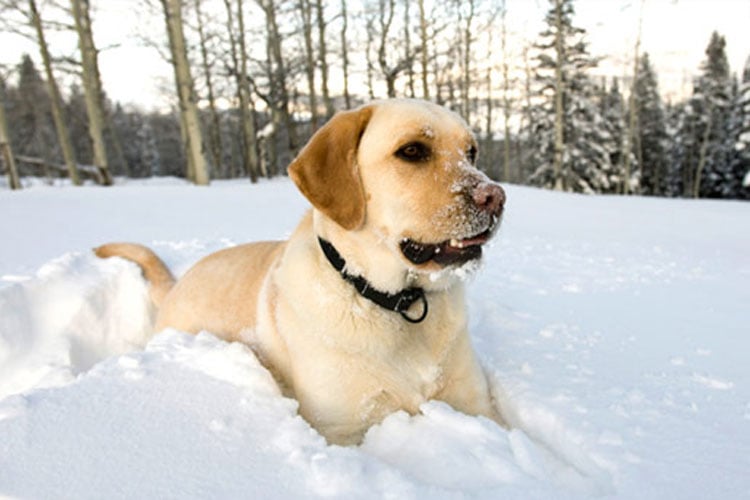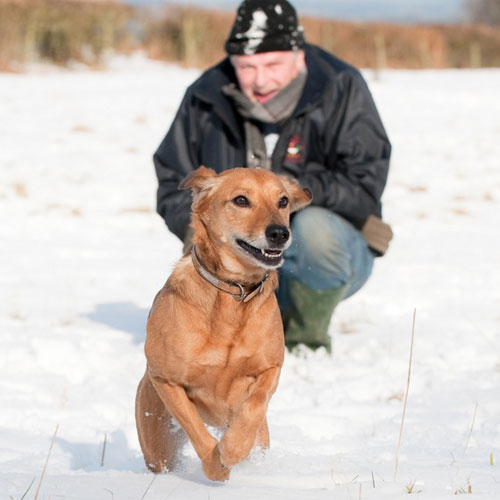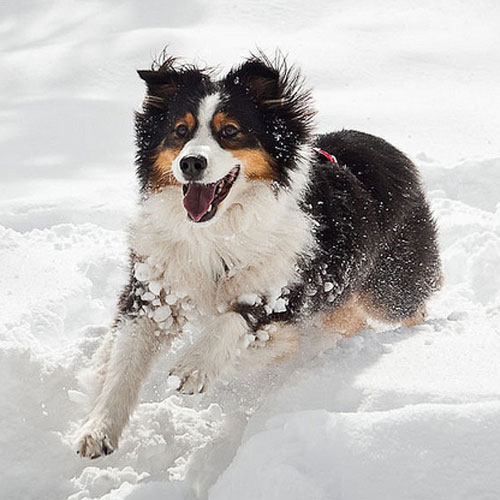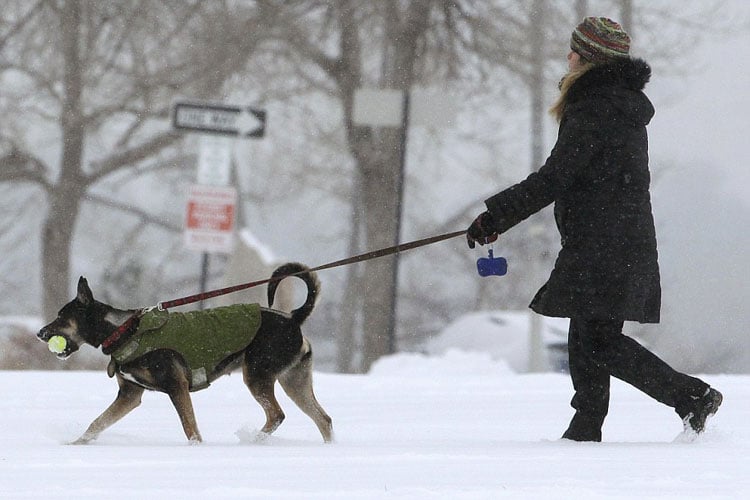Some say it originated in the Australian Outback. Others point to Alaska or Siberia as the source. No matter where it came from, the expression “three-dog-night” means a night so bitterly cold you’d need three dogs in bed with you to keep you warm.
But what about our beloved dogs? They’re always there for us, day and night. What can we do to keep them warm, healthy, and safe during the frigid days of winter? We asked the experts in our Pet Health Centers a few questions on how you can help make this winter a warm and safe season for your best pal.

Q. I’ve heard that all breeds can tolerate extremely cold weather. Is that correct?
A. No. Certain breeds and breed mixes do have a higher tolerance for cold weather. Huskies, Alaskan Malamutes, Newfies, and German Shepherds, for example, like nothing more than a frolic on a cold, snowy day. Their lush, double coats, the shape of their feet, and in some instances, even the thickness of their ears give them an advantage when dealing with cold weather.
But even these snow-lovers need to spend most of their time indoors during the winter months, and every dog is an individual, regardless of breed mix. Observe your dog to learn how he or she responds to cold.
In general, when the temperature dips below freezing, limit your dog’s outdoor activity to 10 to 15 minutes. Watch closely for signs of distress like shivering, lethargy, disorientation, or whining. Just like you, your dog can suffer from hypothermia and frostbite.
If your dog clearly does not like the cold, bring her in immediately. And if necessary, small breeds can “do their business” on indoor training pads when the cold and snow are extreme. Keeping your best friend safe is more than worth a bit of extra effort.


Q. Should I feed my dog more during the winter?
A. Yes and no. If your dog is active and spends a lot of time outdoors, increase his calorie intake slightly and make sure he maintains his ideal weight. All mammals burn more calories in cold weather to regulate their body temperature, especially if they’re active.
On the other hand, most of our furry friends become more sedentary during the winter, just like their couch-loving people. Think about it: If you’re less active, chances are your dog is, too. So for most dogs, the key to helping them maintain a healthy weight year-round is to feed them a bit less during the winter months. Maybe just skip a few treats. Less exercise means less food. What works for us works for Fido, too.
There’s one exception to this rule: puppies. Because they expend so much energy and are developing so rapidly, puppies should be fed more during the winter months, unlike more sedentary adult dogs.
Q. Do dogs drink more water in winter?
A. Heated houses are usually drier houses, and indoor dogs can easily become dehydrated. Just like you, your dog is about 80 percent water, which is crucial for digestion, circulation, and elimination. So keep that water bowl full and clean; wash it daily to prevent bacterial buildup.
Q. Do dogs with special needs require special winter care?
A. Older dogs, those with medical conditions, puppies, and dogs on medication all need special attention during the cold months. Conditions like arthritis, hip dysplasia, diabetes, asthma, hypothyroidism, and heart disease can compromise a dog’s ability to regulate her body temperature. In addition, ice can be as hazardous for your dog as it is for you, especially for an older dog who’s a bit unsteady on her feet.
If there are stairs involved when your dog goes outside, be at her side to help. And take the time to clear a smooth, dry path so your dog can leave the house, take care of business, and return safely to the warmth of home. As a wonderful welcome home gesture, put a big, fluffy towel in the clothes dryer just before you leave for your walk. When you return, first dry your dog thoroughly and then wrap him in that toasty, dry towel, straight from the dryer.
Senior dogs and puppies spend a lot of time sleeping, so be sure your dog’s favorite snooze spots are warm and out of drafts. Wrap a warm hot-water bottle in a plush towel and give it to your dog as a bed partner, especially after a trip outside. This is comforting for all dogs, particularly older dogs and puppies.
Young dogs are especially susceptible to cold-weather problems for the same reasons they’re so adorable: all that puppy energy. To address your puppy’s high energy, consider giving him a good supply of hard chew toys, which can really help burn up energy indoors. When you do venture out, keep it short, no more than 10 to 15 minutes three or four times a day. Watch for shivering, which may indicate hypothermia, and also be aware of frostbite, which occurs when skin reaches a temperature of 23 degrees F for a period of time. Frostbite often shows up as red, painful skin in the webbing between the toes or at the tips of the ears.
Housebreaking a puppy in winter is basically the same as at any other time of year. However, never leave your puppy outside unsupervised, and it’s probably best to wait until the weather improves before moving those training papers outdoors.
Q. I see dogs being walked in my neighborhood wearing coats and little boots. Are these really necessary?
A. Dressing your dog for cold weather is not a fashion statement; it’s a necessity. Many dogs, large and small, have low body fat, especially lean dogs, like Chihuahuas, Greyhounds, and Weimaraners — and all their various mixes. Other dogs, like mixed Poodles, the Shih Tzu, the Maltese, and many Terrier mixes have hair rather than fur. These dogs also appreciate a bit of winter layering. So err on the warm side and buy your dog a cozy, water-resistant coat or sweater. This is important for young dogs, too.
And then there are those booties. Dogs benefit tremendously from wearing waterproof boots during harsh weather. Not only do they protect foot pads from ice and sharp objects hidden in the snow, they also guard against harsh chemicals in ice melt. It’s important that the booties fit well so your dog feels confident and steady on his feet.
Be sure your dog is dry after every outing. And even if he wears booties, check his paw pads for chaffing and irritation from dry, warm heat. There are several moisturizing ointments on the market that soften and treat cracked paws and protect against hot sand and pavement in summer, too.
Q. My dog loves to run off-leash in the winter. Is this a problem?
A. Yes, it certainly could be. Whether or not your dog wears a coat and booties, there’s one accessory he should never be without: his leash. More dogs are lost in winter than at any other time of the year. Snow can disorient your dog, and cold can diminish the power of familiar scents. It’s wise to microchip your dog and be sure he wears a collar with his ID just in case the worst should happen.
In addition, a dog off-leash can suddenly bolt across a field and land on what looks like frozen water — but isn’t — ending up in a frigid, life-threatening situation. Keeping your dog on-leash also helps you control other dangerous winter behaviors like eating snow, which might contain contaminants, or drinking from ditches or gutters where winter runoff can carry poisonous substances like anti-freeze.
Q. Sometimes my dog curls up in front of the fireplace. Should I worry?
A. Fireplaces are irresistible, but they can be dangerous for your dog. Just like us, most dogs are drawn to warmth, but sparks and flames from a crackling fire can hurt him. Be sure to use a fire screen and keep your dog at a safe distance from the fireplace. The same goes for space heaters. Don’t leave your dog unattended in a room with a space heater. It could burn your dog, or he might knock it over, possibly causing a fire. And don’t play with your dog near a roaring fire or a space heater. A little slip could mean a serious burn.
Dogs with breathing problems like asthma should never be exposed to wood burning stoves or irritants like fireplace smoke.

Q. Are there any steps I can take to help me handle winter emergencies?
A. Absolutely. First, talk to your vet. Discuss your dog’s health before the cold weather hits so you’re prepared for any problem that might arise. And ask whether you should take a course in canine first aid. The American Red Cross offers pet first aid and CPR training that could help you deal with your dog’s medical emergency any time year.
And don’t forget: winter weather also means blizzards and power outages, so it’s a smart to create a disaster emergency kit for your entire family, including, of course, your pup. Pack up enough food, water, and meds, including prescriptions, to get everyone through at least seven days.
Q. Is it okay to keep my dog outside all winter?
A. In a word, no! It’s a terrible idea to allow your dog to be outside for extended periods in frigid weather, especially if she lacks adequate shelter. Never chain or tie a dog outside in the cold; doing so prevents her from seeking lifesaving warmth…and water bowls freeze!
If, however, you must keep your dog outside, it’s absolutely essential that you provide her with a warm, solid shelter that protects her from cold, moisture, and wind. Also the floor of the shelter should be up off the ground to prevent heat loss and stay dry. Provide unlimited access to unfrozen food and water, which means changing bowls frequently or investing in heated bowls. The bedding must be thick, dry, and changed frequently to maintain heat and dryness. Don’t use absorbent towels as bedding; when they get wet, they freeze. Do not use space heaters or heated mats in the shelter; both can start fires or burn your dog.
That being said, here’s the humane bottom line: When it’s cold outside, bring your dog inside.

Q. How can I “winterize” my house so my dog is safe inside?
A. If you have a basement or an attached garage that you allow your dog to explore, be careful to store antifreeze, batteries, deicers, cleaning products, and other chemicals securely out of reach. Even a tiny amount of these substances can make your dog deathly ill. Call your veterinarian immediately if you think dog has ingested anything that might be toxic.
We humans tend to get catch colds and get the flu more often in the cold months, so be judicious about putting your own medications safely away. Everything from decongestants and aspirin to Advil and Tylenol can cause seizures and death for your dog. Prescription medications are equally hazardous, so keep that medicine cabinet door closed tight. What’s good for you is possibly deadly for your dog.
Houseplants can also pose a serious threat to dogs. Very often, when we bring our plants in for the winter, we’re unwittingly exposing our dogs to potential poisoning. The list of poisonous plants is long and includes everything from English ivy to cyclamen to mums. Find out if any of your houseplants are dangerous and, if so, give them to someone who doesn’t have a pet.
Finally, though it’s not deadly, dry indoor air can be uncomfortable for you and your dog. A humidifier will help everyone breathe more easily and also keep skin from drying out. Besides, neither you nor your dog enjoys the surprise of a caress charged with static electricity, so when you bathe your dog use a moisturizing dog shampoo and moisturizer. (Some recommend wiping your dog with fabric softener sheets to eliminate this problem. But veterinarians say no! The chemicals in those sheets put dogs at risk each time they groom themselves and ingest the toxins,)
Q. I see dogs left outside all day and all night in the depth of winter. How can I help them?
A. Failing to provide adequate cold-weather shelter for a dog is considered animal neglect, which is a misdemeanor crime in all 50 states and Washington, D.C. If you see a dog living in dangerous and neglectful conditions, document the situation by writing down all the pertinent details (where, when, the temperature, the conditions, etc.) and use your phone to video the scene. Then contact your local animal control officer and make a complaint. If the problem persists after a few days, politely follow up with authorities.
Just remember, you’re the best friend your dog will ever have. To help him make it comfortably and safely through the winter months, all you have to do is combine common sense with some good advice and put yourself in your own dog’s “booties.” If you’re cold and want to come inside, most likely he does, too. Together, you can enjoy all the cozy comforts of winter while waiting for the joys of spring to arrive.


